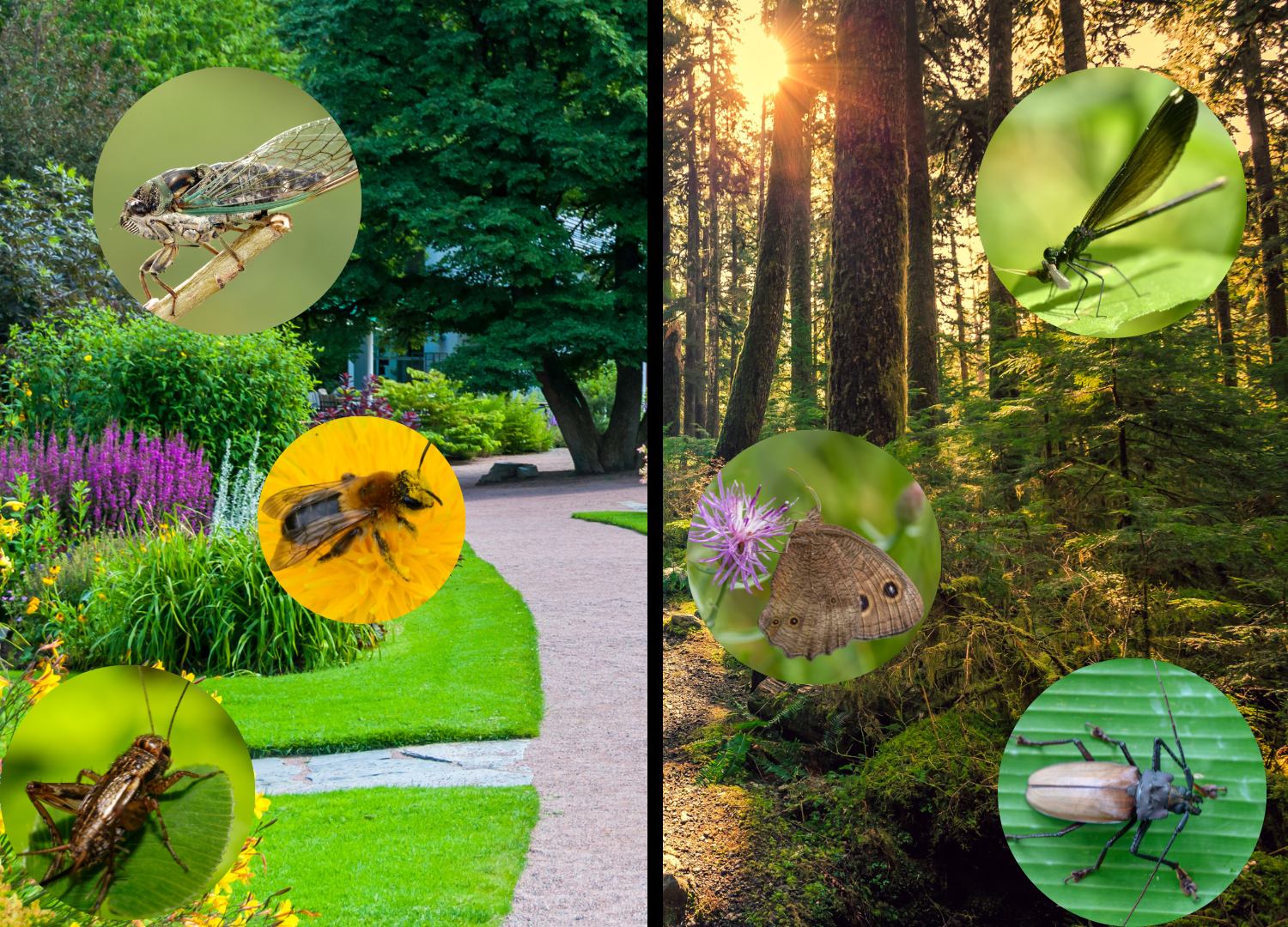Bugs are everywhere in the natural world, and their variety can be overwhelming for beginner naturalists. However, learning a few basics can go a long way in making sense of them. What’s more, becoming familiar with insects unlocks a whole world of nature connection and learning. This applies for kids and adults, alike! This post will introduce you to eight insect orders, or types, that are common in the natural world.
We’ll cover basic groups and their characteristics, so you can better identify insects in your garden or home. If you haven’t already, check out other posts in this Beginner Naturalist Tips series!
Making sense of it all
As you’ll read in the beginner’s guide to taxonomy, scientists use a system called taxonomy to make sense of the natural world. There are millions of species on Earth, and more than half of all species are insects. Because of this, memorizing every single species is virtually impossible. However, knowing the identifying characteristics of certain groups makes it possible to narrow things down.

For example, if you needed to describe a cool car you saw on your commute to work without knowing the model, you might start with car categories. Was it a sedan? A compact? An SUV? These groupings help us make sense of how different cars are similar, and make it easier to identify and describe what we’ve seen.
Different taxonomic levels are helpful for describing different types of organisms. For birds, for example, families are a great place to start. For insects, however, we need to zoom out even further, to orders.
Insect orders: The basics
Insects all share several characteristics, having all descended from common ancestors. These characteristics are things like:
- Six legs
- Antennae
- Three body segments
- Four wings
- Heads with mouthparts for feeding
- Some form of metamorphosis (complete or incomplete)
However, it’s the differences between these characteristics that help us identify and classify different insect orders. In particular, aspects of an insects’ wings and mouthparts are particularly important for distinguishing different orders. The wings are so important, in fact, that the scientific names of most insect orders end in –ptera, Greek for wing.
The 8 most common insect orders
Although there are more than 26 insect orders known to modern science, the vast majority of insects you’ll encounter in every day life belong to just a few. Here, we’ll focus on the following 8 orders:
- Odonata, the dragonflies and damselflies,
- Hymenoptera, the wasps, bees, sawflies, and ants,
- Coleoptera, the beetles,
- Hemiptera, the true bugs,
- Orthoptera, the grasshoppers, locusts, and crickets,
- Lepidoptera, the moths and butterflies,
- Diptera, the true flies,
- Neuroptera, the lacewings and antlions.
1. Odonata: toothed fliers
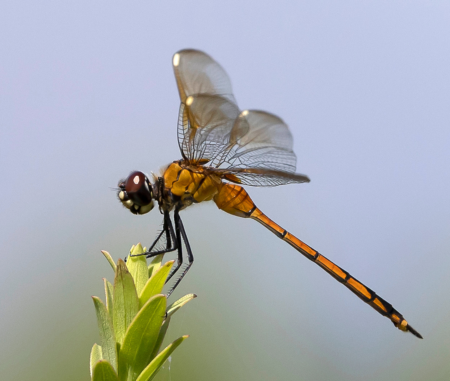
Odonata are all predatory insects with aquatic larvae that are typically found close to water. They hunt aerial prey by capturing it on the wing, and are generally good fliers. The odonates include two suborders. These are the Anisoptera or same-wings, better known as the dragonflies, and the zygoptera or uneven-wings, the damselflies.
Both of these have big jaws for chewing up their captured prey, which is the origin of their order’s name, “the toothed ones”. These groups both have four wings that can move independently, giving them tremendous mobility in the air. They also have long, slender thoraxes and abdomens, giving them a “flying stick” like appearance. Their legs, also for capturing prey on the fly, typically form a basket.
Odonates go through what we call incomplete metamorphosis. This means that their young hatch as a bug-like nymph, then go through several molts to become a winged adult.
Once you know you’ve found an odonate, you can tell damselflies from dragonflies by the following characteristics:
- Damselflies have daintier, thinner bodies while dragonflies are thickly built
- When they land, damselflies fold their wings up above their bodies, while dragonflies leave theirs splayed out to the sides
- Dragonflies’ compound eyes are so large that they touch in the middle of the head, while damselflies’ large eyes are separate.
2. Hymenoptera: the membrane wings

The hymenoptera are a diverse crowd of insects with many different lifestyles. These include:
- Ants, which do everything from fungus-farming to taking down small vertebrates or ranching aphids
- Wasps, some of which are predatory, most of which also feed on nectar. Some species are parasitoids, meaning that their young develop as parasites inside of other animals. Yellowjackets are one commonly encountered wasp.
- Bees, including honeybees, bumblebees, sweat bees, and many others that you haven’t heard of! Most bees feed on plant matter, especially pollen and nectar, and some make honey. Solitary species build nests using a variety of materials.
Hymenoptera usually have very distinct divisions between the head, abdomen, and thorax. Females in this order usually have stingers, which are actually modified egg-laying organs. Fascinatingly, male bees, wasps, and ants do not have this organ, so they can’t sting and can be safely handled!
Although all insects have four wings, the Hymenoptera are a group that looks more as though it has two. The wings on each side of the body fit together like puzzle-pieces, functioning more or less as a single wing.
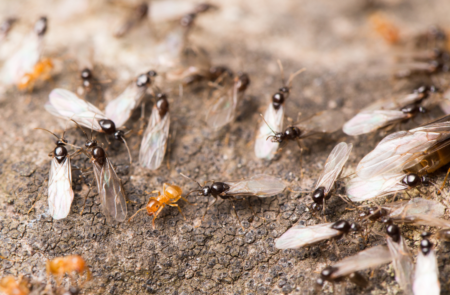
Hymenopteran mouths are just about as varied as their lifestyles, and include long tongues for lapping nectar, and jaws for chewing up soft-bodied prey. They go through complete metamorphosis, meaning that eggs hatch into larvae, which eventually must pupate to become a winged adult. In social hymenopterans like some ants, bees, and wasps, many adults contribute to feeding their maggot-like larvae.
Hymenoptera are often predators, scavengers, or nectar-feeders, which can make them helpful in the garden. Some species, like carpenter bees and carpenter ants, may be pesky in great numbers.
3. Coleoptera: the armored wings
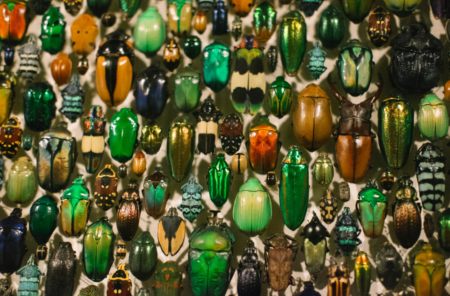
Beetles are the most diverse order of insects. In fact, they are the most speciose (species-rich) order known to science. To be more specific, there are over 350 thousand species of beetles described so far. That alone is more species than there are of plants, of any kind!
Despite all of this variety, most beetles do share some common characteristics. These include:
- Forward wings that are hardened and thickened, acting as a protective shield over the hindwings. These wingcases or elytra don’t help the beetle fly, but provide a suit of armor when they’re on the ground. These, of course, are their namesake.
- Chewing mouthparts. Although beetles eat a lot of different things, the way they do it remains more or less the same. They have paired mouthparts that let them take bites out of food sources and munch away.
- Incomplete metamorphosis. Their larvae are often grub-like, but others are fast-moving, leggy little monsters.
The ground beetle or Carabidae family is one usual suspect within this order. They frequent backyards and gardens, where they are helpful predators of pest species like grubs. Fireflies and junebugs, despite their names, are also beetles, and are frequently encountered during summer.
4. Hemiptera: A bug is a bug?
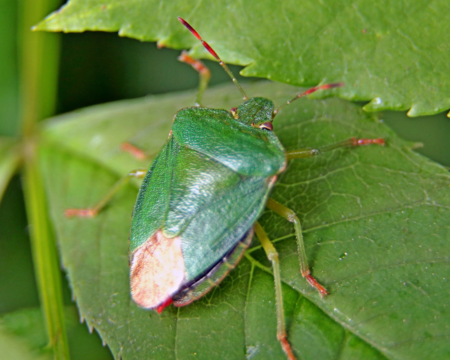
Despite the fact that we tend to call all kinds of insects “bugs”, the name actually applies to a particular order. These “true bugs” are pretty recognizable by several distinguishing characteristics:
- Their wings only “half-overlap” when folded, making a triangle or ‘X’ pattern on their backs.
- They have straws for mouths, or as scientists call them, “piercing-sucking mouthparts”. True bugs stick these into their food source and suck out fluids to eat.
The hemipterans you might best recognize are things like stinkbugs that frequently enter houses or hang out in gardens. Assassin bugs show up in gardens, especially on plants that draw in a lot of bees, and they feed on other insects rather than on plants. Bedbugs are another rather unsavory hemipteran.
Another major group of hemipterans, formerly in their own order Homoptera, are also worth mentioning. These include leafhoppers and froghoppers like the bizarre spittlebugs, as well as cicadas and sharpshooters.
Hemipterans go through incomplete metamorphosis. So much so, in fact, that they can be a little confusing. This is because their nymphs, or babies, often look a lot like miniature adults in their general body shape. The primary difference is that they are wingless, and rely on crawling or jumping to get around.
5. Orthoptera: jumpers and plant-chompers
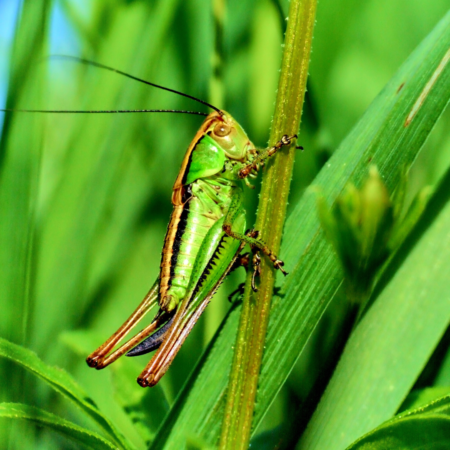
The order orthoptera includes grasshoppers, locusts, katydids, and crickets. As you can guess from these examples, common characteristics include:
- Typically, strong back legs for making long jumps
- Robust, chewing mouth parts for noshing down plants
- The ability to make sounds by rubbing parts of wings or legs together, called stridulation.
Like the bugs, orthopterans can be confusing because their nymphs look almost exactly like them. When you find some, you’ll want to look for wings straight away to know if you’re dealing with an adult or young one.
Field crickets are perhaps the most familiar member of this order to most people. However, in some parts of North America, camel crickets (Rhaphidophoridae) are a common sight in crawl spaces, basements, garages, and barns.
Although they predominantly consist of plant eaters, orthopterans aren’t strict vegetarians. A naturalist mentor of mine once put a large katydid in an enclosure to be a tarantula’s dinner. However, things didn’t go as planned! When we checked on the tarantula the following morning, we found the katydid chewing contentedly upon what was left of it’s body!
6. Lepidoptera: the scaly wings

The lepidoptera are the moths and butterflies. Although people have a pretty intuitive understanding of them, they typically focus on a few characteristics:
- Very large, flat wings, with forewing and hindwing working together
- Scales on the wings which give them color
- Obvious complete metamorphosis, with larvae (caterpillars and inchworms) metamorphosing into adults through a pupal stage. For butterflies, this pupa is known as a chrysalis, while for many moths that spin silk around their pupa, it is a cocoon.
As larvae, moths and butterflies are eating machines! They have chewing mouthparts, and typically chomp away at plants to get their nutrition. However, there are caterpillars that make their living by deceiving ants, or even being predators!
Adult feeding habits differ between butterflies and moths. For example, many moths don’t have mouthparts as adults. Their job is to fly around, find a mate, ensure the next generation, and die. They do this by surviving for a time on fat reserves collected during the caterpillar stage.
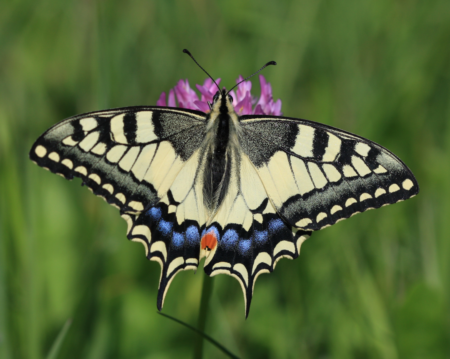
By contrast, butterflies typically have sucking mouthpart which they use to drink nectar and other liquid foods. Unlike hemipterans, this mouth part can’t pierce things, but is a long tube, rolled up like a party favor under the butterfly’s head. This proboscis extends out when they need it and can probe into flowers to feed.
Common lepidopterans in North America include invasive species like the spongy moth, the beloved monarch butterfly, and swallowtail butterflies.
7. Diptera: two-wings
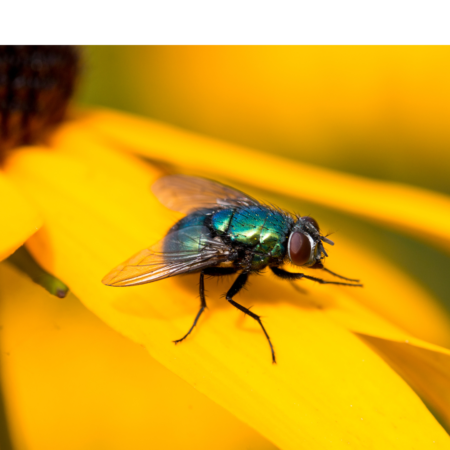
Diptera, meaning two-wings, is the order containing what we like to call flies. Unlike butterflies, dragonflies, and fireflies, these are considered “true flies”, the way hemipterans include true bugs. Among insect orders, flies may be among the most common household bugs.
Flies get their scientific name because they only use two of their four wings for flying. The other pair of wings have been reduced to little club-like appendages called halteres. If you spot an insect with only two obvious wings and these little halteres, it’s a great way to know you’ve got a fly.
Interestingly, having only two wings to contend with makes flies excellent fliers. In case it wasn’t obvious from how hard it can be to swat them!
The order Diptera includes a lot of unpleasant, pesky species that people might not be fond of. For instance, these might include:
- Mosquitoes, horseflies, and other biting flies
- Houseflies, blue-bottles, and dungflies
- Botflies (ew!)
- Gnats and no-see-ums

All that being said, the diptera get a bad rap from species like these. In fact, there are actually many very beneficial species. For example, robberflies are excellent predators of flying pests. On the other hand, hoverflies or flowerflies are excellent pollinators, even capable of out-performing some bee species!
8. Neuroptera: the net-wings
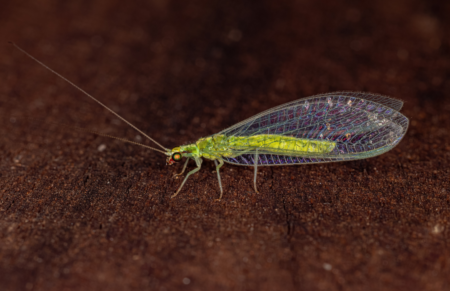
While not the most common among insect orders, neuroptera are too cool not to mention. Neuroptera are an ancient group of insects that have four large, transparent wings. They get their name from the way that the otherwise clear-ish wings are crisscrossed with a lattice of veins.
Neuropterans are slow, kind of clumsy fliers, and their four wings are all the same size. They have strong jaws for chewing foods and are typically predatory as adults. Their larvae are also predators and often specialize in one particular type of prey.
For example, antlions famously build funnels in sandy soil that trap hapless ants. When the ant falls in, the tiny larva at the bottom can pull it under and feed on it.
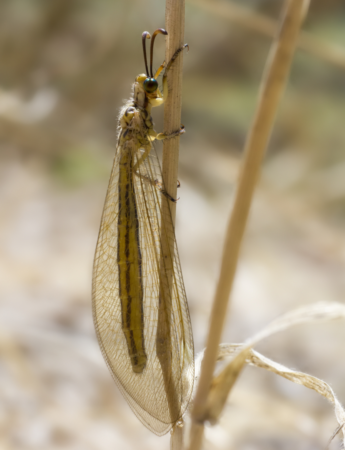
Lacewings are perhaps the most commonly encountered neuropterans in North America. Their larvae are active hunters, and very helpful beneficial insects in wildlife gardens. They camouflage themselves in bits of dust and dirt that they find while wandering around. As a result, they can look like little walking dustbunnies as they search for prey!
Lacewing larvae are voracious predators of aphids and other plant-sucking insects. This makes them a fantastic garden ally.
Thanks for reading about insect orders!
Did you find this post helpful for making sense of your local bugs? Would you like to know about any other insect groups? Let us know in the comments or using the Contact page! If you enjoyed this post, please share on Social Media.

